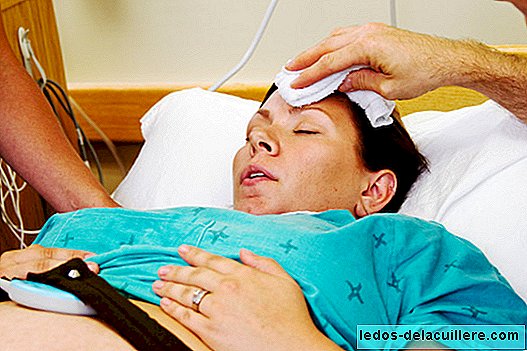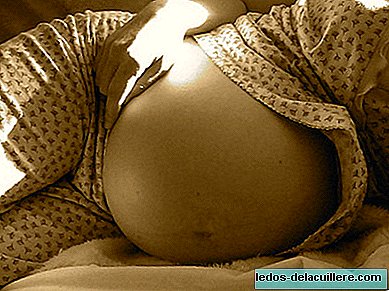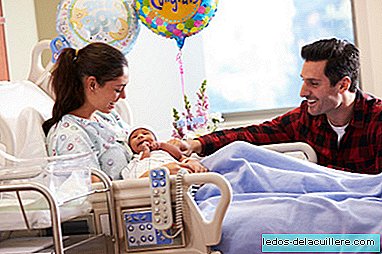Uterine rupture happens when there is loss of integrity of the wall of the uterus. The most commonly involved risk factor is the existence of previous uterine surgery, such as caesarean section, although there are other related factors that we will discuss next.
Uterine rupture is not very frequent, but it is a complication of pregnancy or childbirth that in the most severe cases (complete or catastrophic uterine rupture) can cause the death of the mother and the fetus. Therefore, in the face of this obstetric emergency that involves a rapid deterioration of maternal and fetal health, early diagnosis and treatment is essential.
This, together with the progress in health care measures, has significantly reduced maternal mortality in our area. But to what extent does it occur? What types of uterine rupture exist? Can it be prevented? We tell you everything in this article.
Incidence of uterine rupture
The frequency of uterine rupture is very variable, and while some authors report 1 spontaneous rupture every 2,000 births, others raise frequencies of 8 per 1 000 births in African countries. In developed countries, uterine rupture accounts for 0.02-0.08% of all deliveries.
In any case, according to the Obstetrics and Gynecology Service University Hospital Virgen de las Nieves Granada, the rupture of an intact uterus is very rare, its incidence is estimated between 1/5700 and 1/20000 pregnancies. Most uterine tears occur in cases with previous scar.
In fact, the incidence of uterine rupture has been increasing due to the increase in vaginal deliveries after previous caesarean section. It currently ranges between 0.3 and 1%, being 0.78% in women in whom an attempt at vaginal delivery after caesarean section takes place.
Regarding the risk of recurrence, if a uterine rupture has already been suffered, there are studies that indicate an increase in the risk of uterine rupture from 22 to 100%, being greater when the lesion affects the uterine fundus.
Types of uterine rupture

There are very different classifications of uterine ruptures, according to different criteria. Let's see the most frequent:
- According to its depth or degree:
Complete uterine rupture it is the proper one, when the disruption of all the layers of the wall of the uterus, including the serosa, occurs, so there is a direct communication with the abdominal cavity. It has important maternal-fetal morbidity and mortality, which can lead to severe bleeding, bladder rupture, hysterectomy, fetal hypoxia. In developed countries the main cause is the attempt of vaginal delivery after previous caesarean section, while in developing countries the main cause is the stagnation of the expulsive with the impossibility of instrumental delivery.
On the other hand, incomplete uterine rupture or dehiscence occurs when the serous layer remains intact, so there is no communication with the abdominal cavity. In many cases it remains hidden and has no obvious clinical manifestations. In this case the complications are much milder, since the fetal membranes are not broken, the fetus remains in the uterine cavity and bleeding does not occur or is minimal. Sometimes the diagnosis is made in subsequent caesarean sections, or in imaging tests during pregnancy.
- According to the mechanism that causes or causes it:
Spontaneous ruptures (due to myometrial weakness): scars, uterine wall lesions (ademiosis, tumors, etc.), thinning of the wall (hypoplasia, large multiparity, repeated curettage, manual births, etc.), myometrial invasion due to trophoblastic disease.
Passive (traumatic): External trauma (accidents, stab wounds or firearms, etc.) or internal (obstetric maneuvers).
Active (hyperdynamic): In directed deliveries (inadequate oxytocin stimulation) or spontaneous (pelvifetal disproportion, transverse situation).
According to the moment: during pregnancy, especially related to the causes: gestational trophoblastic disease, trauma (accidents, penetrating wounds, etc.), placenta percreta; and during childbirth, which is the most frequent, usually due to a previous uterine scar dehiscence. Postpartum rupture may be related to fetal extraction, instrumental delivery, manual delivery ...
According to extension and location: vaginal rupture, cervical supravaginal, segmental (the most frequent, because this area is the weakest in the uterus), lateral ...
Depending on their direction, the uterine rupture can be longitudinal, transverse, oblique, mixed or starry rupture.
Signs and symptoms
They are established as Premonitory signs and symptoms of uterine rupture during childbirth the following:
- Abnormalities in fetal heart rate: The most frequent is the appearance of severe bradycardia that may be preceded by late decelerations. Fetal death.
- Vaginal bleeding: may be moderate, mild, and even non-existent. The increase in bleeding is very typical when moving the presentation by vaginal touch.
- Intra-abdominal hemorrhage: manifests with the hemodynamic deterioration of the mother.
- Sudden abdominal pain or worsening of it. Keep in mind that this pain could be masked by anesthesia.
- Bloating and swelling of the lower uterine segment, painful on palpation and persisting even with the uterus relaxed.
- Alterations in uterine dynamics: hyperdynamics, followed by a progressive decrease in the intensity of contractions.
- Acute abdominal pain coinciding with the contraction, with a tearing sensation that radiates throughout the abdomen, and even the shoulder due to peritoneal irritation.
- Abrupt cessation of contractions, with improvement and pain relief.
- Palpation of fetal parts more easily than in normal conditions, and of a uterus contracted just above.
In the postpartum period, the ruptures that have taken place during childbirth are manifested with pain, tachycardia, deterioration of the general condition of the patient and vaginal bleeding that does not stop with the administration of uterotonics. There may even be blood in the urine if the bladder has also been affected. The time it will take for the manifestations to appear will depend on the severity of the breakage, taking hours in the case of minor breaks.
Risk factors for uterine rupture
 Among the gynecological factors are multiparity, multiple pregnancy, abnormalities and tumors of the uterus, uterine legrados and uterine scars (myomectomy with entry to the cavity, especially intramural and submucosal myomas)
Among the gynecological factors are multiparity, multiple pregnancy, abnormalities and tumors of the uterus, uterine legrados and uterine scars (myomectomy with entry to the cavity, especially intramural and submucosal myomas)Related to obstetric care are factors such as inadequate monitoring of labor, particularly in narrow pelvis; undervalued fetal macrosomia; unsuitable instrumentation; improper use of oxytocin; Kristeller maneuver ...
Remember that the Kristeller maneuver has been under suspicion for many years because although its prevalence is unknown, it carries with it a trail of bad reputation that seems to discourage its use, since it is said that, apart from uterine rupture, it could cause fractures in the baby and even brain damage.
In addition, there are other circumstances that could favor uterine rupture, although their relationship is not clear: advanced maternal age, advanced gestational age, interval between births under 18-24 months and hysterorrhaphy in one layer.
How to prevent uterine rupture
The Spanish Society of Gynecology and Obstetrics, in its protocol of uterine rupture of 2013, proposes between the most recommended measures to try to prevent uterine rupture the following:
- Properly control the use of oxytocin, mainly in large multiparas, prolonged deliveries and dead fetuses if associated with prostaglandins.
- Properly select cases of caesarean section before allowing vaginal delivery. Avoid using misoprostol in previous caesarean sections.
- Shorten the waiting time in the active phase of labor without progression (parked delivery) and the expulsion period in women with previous caesarean section.
- Avoid excessive fundic pressures in the second phase of labor, since they can cause damage and do not resolve dystocia.
- Avoid traumatic deliveries and maneuvers, mainly in women with a previous uterine scar.
- Indicate elective caesarean section in women with longitudinal anterior or inverted T-caesarean section, with more than two previous caesarean sections, with opening of the endometrial cavity during uterine surgery (except caesarean section) or with previous uterine rupture.
- In women with previous caesarean section with associated factors such as gestational diabetes, macrosomia, need for induction or podic presentation, there is no contraindication for vaginal delivery, but caution should be exercised.
- In other factors such as obesity, hysterraphy in one layer, fever in the puerperium of the previous caesarean section and maternal age, there are no data that allow definitive conclusions to be drawn.
In general, most uterine ruptures can be avoided with the following measures: good prenatal care and taking into account the risk of rupture in patients with the above factors, as well as obstetric work with timely diagnosis of vicious presentations, narrow pelvis and Performing maneuvers and instrumentation when strictly indicated.
In the event that an impending rupture is seen, the professional medical staff should stop the contractions with tocolytic and remove the oxytocin. The maneuvers and instrumentations are contraindicated and the general anesthesia that is administered to give definitive solution helps to stop uterine activity.
Already produced uterine rupture The oligohemic shock is treated and an urgent laparotomy will be performed, almost always, for total hysterectomy, the most serious maternal consequence (together with its possible complications). For the fetus, the worst is perinatal death and neurological injury due to hypoxic-ischemic encephalopathy.
Caesarean section and uterine rupture

A woman who has given birth by caesarean section has a scar on the uterus. This causes that in the following delivery there is a risk of uterine rupture, but although there was a time when this condition was synonymous with giving birth again by caesarean section, recently vaginal delivery after caesarean section is considered safe.
The Royal College of Obstetricians and Gynaecologists (RCOG) of the United Kingdom developed a birth care guide that ensures that vaginal delivery after caesarean section has a success rate of around 75%, which is the same as for new mothers. Even after having previously two caesarean sections or more, may have a vaginal delivery up to 71% of women, so it is also recommended to try.
In general, gynecologists and midwives point out that after twelve months of caesarean section, the scar is well sealed. What can be done to minimize the risk in the second birth is to intervene as little as possible, without forcing the delivery or accelerating it and maintaining continuous surveillance:- Continuous fetal monitoring.
- Control of uterine dynamics (preferably by intrauterine catheter).
- Avoid excessive prolongation of labor (instrumental help if necessary).
- Clinical assessment of postpartum bleeding.
There are studies that indicate that the vaginal delivery before, before or after a C-section, could be considered a protective factor against uterine rupture (the risk of rupture is lower if it is the second vaginal birth after a C-section or else there was already a birth vaginal prior to said caesarean section).
This complication has been described in 0.7% of vaginal deliveries induced with oxytocin in pregnant women with this history. The most frequent is sudden cardiotocographic alteration. This, in women with previous caesarean section, without another justified cause, makes a uterine rupture suspect.
Photos | iStock
More information | Emergency Nursing, HVN
In Babies and more | When should you go to the emergency room if you are pregnant?












